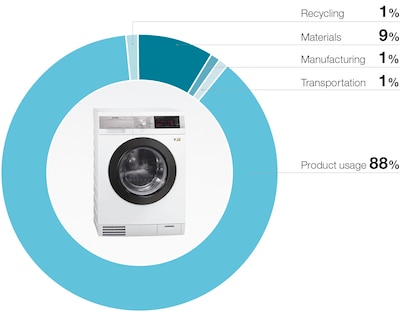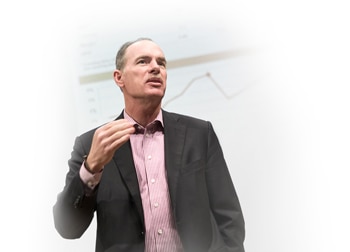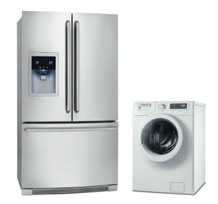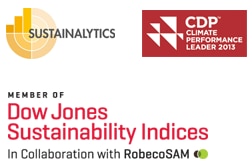Carbon target
The product life-cycle approach guides the Group in reducing its environmental impact by indicating the degree of impact in raw-material extraction, manufacturing, transportation, use and end-of-life treatment.
Carbon impact – product life cycle

The most significant environmental impact for Electrolux is energy and water consumption during the use phase of products. The design and development of products with increased efficiency is a top priority. The impacts from manufacturing and transport are significantly smaller.
The graph shows the CO2 impact across the life cycle of a typical household appliance. Data has been calculated by taking the average life cycle of 11 different household appliances including ovens, vacuum cleaners, refrigerators/freezers, washing machines and dishwashers.
Reducing our footprint by 50%
Electrolux is cutting its CO2 impact by 50% by 2020 relative to 2005 production levels. Approximately 25 million tonnes will be cut in emissions deriving from product use, use of greenhouse gases, in production and transportation.
| Product use | Greenhouse gases | Energy use in production | Transportation |
|---|---|---|---|
| Electrolux is setting efficiency targets for its products. To achieve this, Group products must be among the leaders in energy efficiency in each product segment and market. | The Group’s 2020 objective is to eliminate all greenhouse gases with a global warming potential higher than 15 in products. | The Green Spirit program‘s 2020 objective is to reduce energy consumption by more than 50%. | As a first step to reducing the CO2 impact of transportation, a target has been set to reduce emissions by 15% between 2010 and 2014. |
CEO Statement

In 2013 we continued to deliver above our growth target and delivered 4.5% in organic sales growth.
CEO Statement

I'm convinced that raising product efficiency for the growing middle class is where long-term shareholder value creation lies.
Our products

Electrolux is the only appliance manufacturer in the industry to offer complete solutions for both consumers and professionals. The focus is on innovative and energy-efficient products in the premium segments.
Sustainability
Achieving the Group's vision of sustainability leadership is crucial to realizing the business strategy. The objective is to develop smarter, more accessible, resource-efficient solutions that meet people's needs and improve their lives. Read the comprehensive sustainability performance review.
Awards & recognition

Financial Reporting
Net sales for the Electrolux Group in 2013 amounted to SEK 109,151m, as against SEK 109,994m in the previous year. The organic sales growth was 4.5%, while currencies had an impact of -5.3%.
